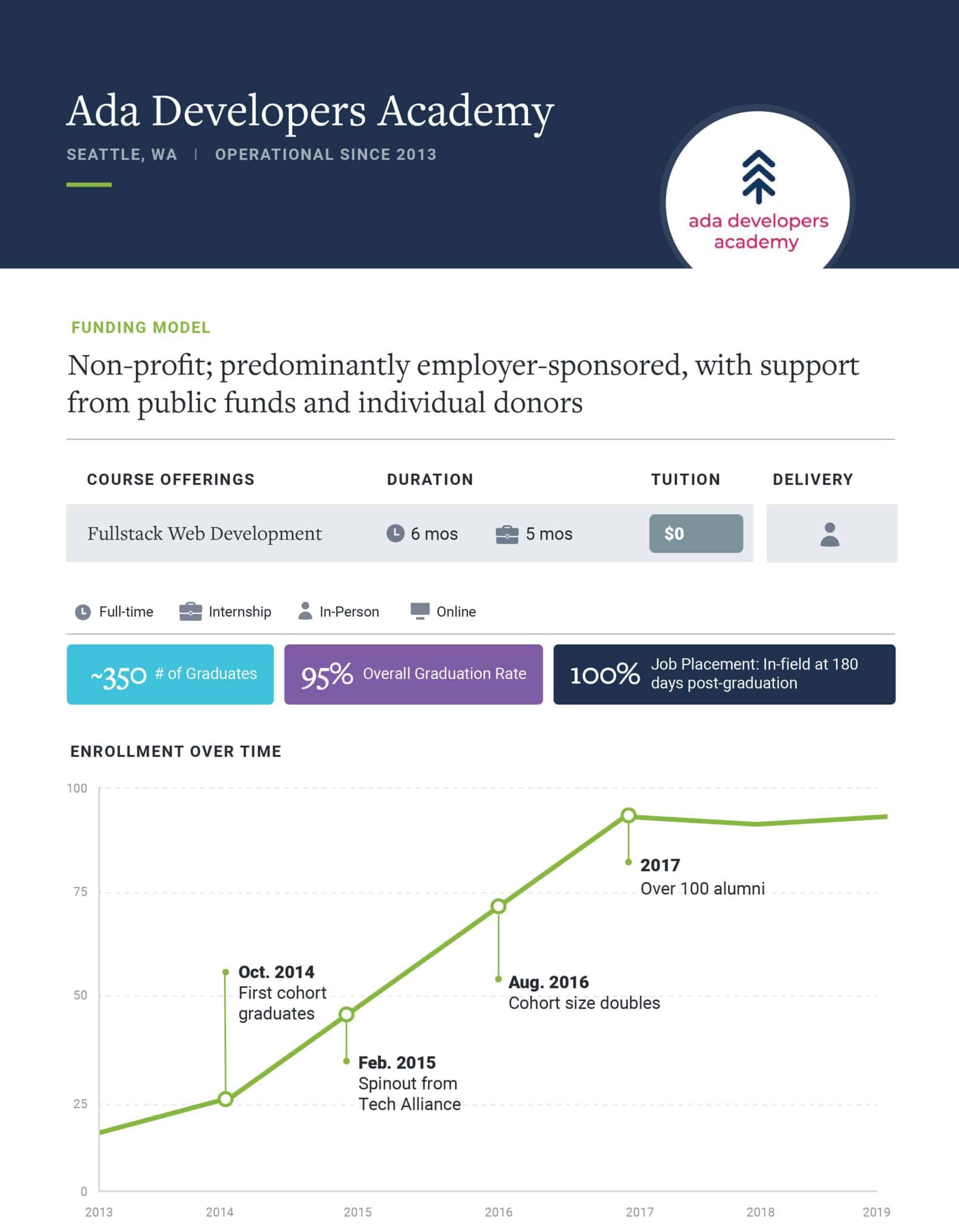Bootcamps focused on coding and computer science have emerged as an important pipeline for tech talent. We conducted in-depth interviews with seven leading bootcamps to better understand their outcomes-focused business models. We are now sharing their stories, this being the third profile. For more on the disruptive potential of bootcamps, read our recent paper, Betting on Bootcamps.

Scott Case was frustrated. His company was struggling to bring gender diversity to its growing team of software developers, and he wasn’t the only one: at the time, in 2013, only 15% of software developers in Washington state were female. One of those female developers was a family friend, Elise Worthy, with whom Scott shared his diversity challenges. In turn, Elise expressed to Scott how tired she was of being the only woman on her team. Out of these conversations was born the idea of Ada Developers Academy, a non-profit bootcamp focused on diversifying the technology sector by training women and gender-diverse people to become full-stack software developers.
This focus on closing the gender gap drew the attention of the Technology Alliance, a non-profit organization dedicated to fostering innovation in Washington state. The Technology Alliance incubated Ada and helped secure state workforce funding. Ada used that funding, along with early corporate sponsorships from Seattle area companies like Expedia and Zillow, to make the bootcamp tuition-free for students. A little over a year later, in early 2015, Ada was able to spin out of the Technology Alliance and stand on its own.
As is true for many bootcamps, Ada iterated through different cohort sizes and course durations before finding the right mix for its full-stack web development curriculum. Initially, students attended seven months of full-time, in-person classroom instruction in Seattle, followed by a short break before entering into a six-month paid internship with a local employer partner trying to address gender imbalances within its ranks. The first cohort had 15 students. Feedback from students and employers that the program and internship were too long led Ada to scale back and eliminate the break.
Ada students, or “Adies,” now attend six months of in-person classroom instruction followed by a five-month paid internship. Ada also increased its cohort size to 24 and tried teaching three cohorts per year before concluding that two would be more feasible given the rigorous and time-consuming admissions process (Ada admits about 10-12% of applicants). Since then, Ada has grown to where it can teach two cohorts of 48 students per year through its program. These students are typically bachelor’s degree holders looking to change careers. All admitted students are women or gender diverse, and nearly 75% identify as a person of color.
Ada is fiscally sponsored by TSNE MissionWorks, which supports much of the operations infrastructure that has allowed Ada to grow, and keeps its program tuition-free through support from over 80 Seattle employers in the tech industry. These employer partners pay a standard flat fee per intern that covers both the cost of classroom instruction and a stipend for the internship portion. They also hire Adies for the aforementioned internships, with the option to convert them to full-time employees if the pairing is successful. Individual philanthropic donations supplement the support provided by area employers. Students incur only the costs of living expenses. Ada offers low-interest loans that students can use for those expenses during the classroom portion of the program, and in some cases offers scholarships as well.
In the classroom, instructors cover technical skills, such as programming languages and coding best practices, as well as soft skills, such as leadership, networking, diversity and equity awareness, and career readiness. The program also teaches relevant practical skills, including lessons in personal finance to help students better manage the higher salary they will be earning.
In order to keep its curriculum workforce-relevant, Ada takes a three-pronged approach. The bootcamp’s primary form of external engagement consists of regular consultation with its employer partners, who highlight emerging technical skills that give Adies a competitive advantage. Ada also taps its alumni through periodic surveys for a boots-on-the-ground perspective. Finally, members of the instructional team have industry experience, and Ada encourages them to stay in touch with the developer community through personal connections and conferences.
So far, Ada’s results seem promising. With most cohorts, all graduates find jobs within six months of finishing the program. In a recent survey of the alumni population, of the 68% that responded, all still had jobs in the tech industry as either software development engineers or technical program managers. They cite a 95.6% job placement rate in software developer roles specifically, with placements in companies like Microsoft, Amazon, and Expedia. Moving forward, the program aims to add indicators to better track alumni outcomes over time, such as length of time in their first role and until their first promotion, and employer and student satisfaction, all broken out by demographic.
Ada is actively strategizing on growth opportunities going forward. In the meantime, the bootcamp has focused on depth over breadth, exploring its possible role in its graduates’ lifelong learning trajectory. Ada is continuously improving its current offering and finding ways to upskill its graduates throughout their career paths.
“While our current program focuses on getting women and gender-diverse people started in software engineering roles, we see room for improvement around long-term support for retention and career growth,” explained Interim Executive Director Christine Martin. “How can we help them rise from a junior position to something like lead engineer or engineering manager? We want to make sure alumni are in it for the long run, finding joy and satisfaction as software engineers for the next 5, 10, or 15 years.”
Our other bootcamp profiles:



